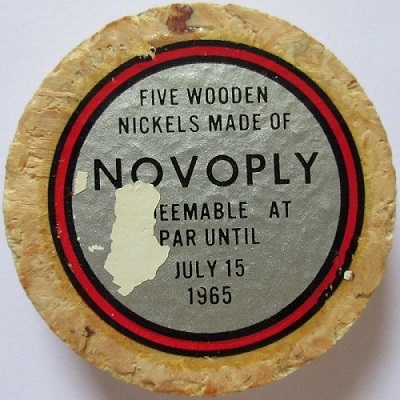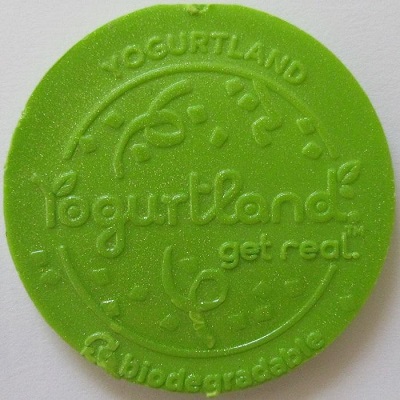|
|
This page may contain links that result in small commissions to keep this free site up and running.
Welcome Guest! Need help? Got a question? Inherit some coins?
Our coin forum is completely free! Register Now!
nautilator's Last 20 Posts
| Question About Unusual Coinage Materials/Post Your Unusual Materials Coins!
|
|
nautilator
Valued Member
United States
324 Posts |
 Posted 11/22/2024 9:37 pm Posted 11/22/2024 9:37 pm
|

Got this today. It's a tin 11-cent piece issued in Malaysia in the mid-1700s. The rooster had a defined value of 5 cents while each ring had a value of 1 cent.
The reason for this unusual design was it was meant to be cut up to make change. And cut they were. Original, uncut pieces are extremely rare and difficult to find. If you're wondering, this is about 4 inches long and weighs a little more than an ounce.

This is a token that was issued by the British Sub Aqua Club in Jamaica. Though it does not display a denomination, it had a value of 5 shillings. It was issued because collecting money for bottles of air was difficult. Because of the cost of ordering tokens was high, the club made their own -- out of brass washers.

I do not have this in hand yet but I will soon. This is a gold Spanish 4 escudos from the 1700s -- except it's actually a contemporary counterfeit. It was made with a trash metal called platinum. At the time, platinum had no known uses and was the only metal readily available that could match the density of gold. Contemporary platinum counterfeits are scarce but come up for sale reasonably often. This is one of the few instances where I think a counterfeit fits well with material collecting.
|
| | Forum: "Post Your..." Gallery Topics |
| |
| Question About Unusual Coinage Materials/Post Your Unusual Materials Coins!
|
|
nautilator
Valued Member
United States
324 Posts |
 Posted 05/25/2024 10:45 am Posted 05/25/2024 10:45 am
|
Fiber tokens were especially common during WWII due to conservation of metal for war purposes.
What they did, I think, was dissolve paper in zinc chloride solution to create layers of paper atop each other. You can see that along the edge of any true fiber token.
(I say true fiber token because things like the Manchuoku 'fiber' tokens do not have this layering and are not actually fiber.) |
| | Forum: "Post Your..." Gallery Topics |
| |
| Question About Unusual Coinage Materials/Post Your Unusual Materials Coins!
|
|
nautilator
Valued Member
United States
324 Posts |
 Posted 03/22/2024 09:34 am Posted 03/22/2024 09:34 am
|
That token looks pretty well-struck. For some of those, the lines across the shield don't really come out visibly.
Coin club and related tokens tend to be thoroughly shunned by most people, which I think is a shame. There are a number of nice club tokens that have been made over the years and at least one material (balsa wood) where I think can only be found with coin club tokens. |
| | Forum: "Post Your..." Gallery Topics |
| |
| Question About Unusual Coinage Materials/Post Your Unusual Materials Coins!
|
|
nautilator
Valued Member
United States
324 Posts |
 Posted 11/26/2023 1:42 pm Posted 11/26/2023 1:42 pm
|
So, I got this yesterday.
 
It's a bone gambling token, which are pretty common, but this one was used in the Dexter Saloon in Nome, Alaska aka the one that Wyatt Earp founded.
Also have a number of other things I realized I haven't pictured yet.

Akita Japan 100 mon coins from 1862. These are the first coins I've come across that are copper-plated lead. Of course, Samuel H Black made advertising tokens to that effect, as things that are called electrotypes all are.

While it's kind of arguable if this Store K bottle might be considered a trade token, it does say 'good for 5 cents' on it, and similar things (like the clay jug from Alabama) are.
 
While I've noted Tenino's colorful cedar wood depression scrip before, the 50c one is new for me. 50c and $1 denominations are much scarcer than 25c ones, and cedar wood scrip is much scarcer than spruce wood ones. The 50c has a low serial number to boot.

We mentioned Rwanda's Noble 7 early on but this is from the Noble 5. They had different designs each year. This one is the world's first iridium coin and weighs in at a whopping 1/25th of an ounce. That actually makes it pretty valuable considering the price of iridium.

One more -- silver is not a rare material but I do like the distinctive silver coins. These are Thai tiger tongue moneys (c. 90-100g size, large) and silver tamlung coins (c. 10-20 g size, small).
|
| | Forum: "Post Your..." Gallery Topics |
| |
| Question About Unusual Coinage Materials/Post Your Unusual Materials Coins!
|
|
nautilator
Valued Member
United States
324 Posts |
 Posted 08/16/2023 9:34 pm Posted 08/16/2023 9:34 pm
|
I think this is where I left off.

The Border Scouts were a militia group situated in Upington, South Africa during the Boer Wars. After going on for months without pay and there being no paper in the area, someone got the bright idea of cutting up surplus military uniforms and reissuing them as money. There are a few varieties of this issuance of money and all are rare.
 
This is the first German shooting medal I've seen made of leather. A local dealer found this one for me.
 
Those Argentinian independence medals that come in curupay and mora wood were also made of urunday.
 
Pocket barometers had a paper strip that changed color according to the weather. Most were made with vulcanized rubber. This one dates to the 1880s and yes, they are listed as tokens in the Schenkman Hard Rubber Tokens book. There are apparently far more of them out there than were listed there, though.
 
Certain guitar picks that were (and are) being given out by bands on tour also double as drink tokens. This one is from this year.
 
These austere tokens were issued by John Krosby of Norway as householder money in the 1830s. This particular one had a value of 6 skilling.
 
This is presumably a pilgrim's badge as it was discovered near the Pilgrim's Way in England. It is carved out of slate.
 
I was happy when I found this, only to realize that it's apparently the second medal that this company made of milk (or casein -- milk protein). If anybody finds the other, let me know.
 
Stickers on coins are common. Stickered coins where the sticker is a good-for are scarce.
 
This so-called dollar celebrates Joseph Wharton, who lobbied the US to make coins out of nickel, then founded the Wharton School of Business, and then founded INCO when the nickel ran out in Gap, PA. It is, of course, made with pure nickel.
|
| | Forum: "Post Your..." Gallery Topics |
| |
|
| Coin Community Forum |
© 2005 - 2025 Coin Community Forums |
| It took 0.6 seconds to rattle this change. |
 |
|




















































































